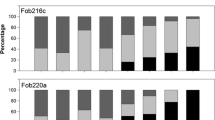Abstract
Tomato plants, susceptible toFusarium oxysporum f. sp.lycopersici, were inoculated by immersing the roots in a conidial suspension ofF. oxysporum f. sp.lycopersici race 1,F. oxysporum f. sp.dianthi race 2 or a mixture of both fungi. Plants inoculated withF. oxysporum f. sp.lycopersici showed disease symptoms after 2 weeks, whereas plants inoculated withF. oxysporum f. sp.dianthi or a mixture of both fungi remained symptomless for over 7 weeks, the duration of the experiment.
In another experiment root systems of plants were split and each half was separately inoculated. One half was firstly inoculated withF. oxysporum f. sp.dianthi or treated with water, followed after a week by a second inoculation of the other half withF. oxysporum f. sp.lycopersici or by a water treatment. The disease symptoms in the half firstly inoculated withF. oxysporum f. sp.dianthi were significantly delayed, compared to plants of which that half had been treated with water. BecauseF. oxysporum f. sp.dianthi reduced disease symptoms caused byF. oxysporum f. sp.lycopersici without any direct interaction with this pathogen, it is concluded thatF. oxysporum f. sp.dianthi is able to induce resistance againstF. oxysporum f. sp.lycopersici in tomato plants.
Similar content being viewed by others
References
Alabouvette, C, 1990, Biological control of fusarium wilt pathogens in suppressive soils. In: Hornby, D. (Ed.), Biological control of soil-born plant pathogens, C.A.B. International, Wellingford. pp. 27–43.
Anchisi, M., Gennari, M. & Matta, A., 1985. Retardation ofFusarium wilt symptoms in tomato by pre- and post-inoculation treatments of the roots and aerial parts of the host in hot water. Physiological Plant Pathology 26: 175–183.
Biles, C. L. & Martyn, R.D., 1989. Local and systemic resistance induced in watermelons by formae speciales ofFusarium oxysporum. Phytopathology 79: 856–860.
Bovio, M, Abbattista Gentile, I. & Matta, A., 1987. Release of ethylene following abiotic and biotic stimuli that induce resistance toFusarium wilt of tomato. Phytopathologia Mediterranea 26: 177–182.
Davis, D., 1968. Partial control of Fusarium wilt in tomato by formae ofFusarium oxysporum. Phytopathology 58: 121–122.
Ferraris, L., Abbattista Gentile, I. & Matta, A., 1987. Variations of phenols concentration as a consequence of stresses that induce resistance toFusarium wilt of tomato. Zeitschrift für Pflanzenkrankheiten und Pflanzenschutz 94: 624–629.
Gessler, C. & Kué, J., 1982. Induction of resistance to Fusarium wilt in cucumber by root and foliar pathogens. Phytopathology 72: 1439–1441.
Hillocks, R. J., 1986. Cross protection between strains ofFusarium oxysporum f. sp.vasinfectum and its effect on vascular resistance mechanisms. Journal of Phytopathology 117: 216–225.
Langton, F.A., 1969. Interactions of the tomato with two formae speciales ofFusarium oxysporum. Annual applied Biology 62: 413–427.
Maraite, H., 1982. Induced resistance in musk melon wilt: facts and limitations. In: Wood, R. K. S. (Ed.), Active defense mechanisms in plants: 339–340.
Matta, A., 1989. Induced resistance to Fusarium wilt diseases. In: Tjamos E.C. & Beckman, C. (Eds), Vascular wilt diseases of plants, NATO ASI Series 28: 175–196.
Phillips, D.V., Leben, C. & Allison, C.C., 1967. A mechanism for the reduction of Fusarium wilt by aCephalosporium species. Phytopathology 57: 916–919.
Puhalla, J.E., 1985. Classification of strains ofFusarium oxysporum on the basis of vegetative compatibility. Canadian Journal of Botany 63: 179–183.
Snedecor, D.W. & Cochran, W.G., 1980. Statistical methods. The Iowa State University Press, Arnes, Iowa, U.S.A.: 144–146.
Vanachter, A., Van Wambeke, E. & Van Assche, C., 1978. Influence of preinoculation treatments againstFusarium oxysporum f. sp.lycopersici on disease development in tomato plants. Mededelingen Faculteit Landbouwwetenschappen Rijksuniversiteit Gent 43: 873–880.
Verma, P.S. & Allison, C.C., 1970. Possible modification of susceptibility of tomato to Fusarium wilt by aChaetomium sp.. Phytopathology 60: 1318.
Author information
Authors and Affiliations
Rights and permissions
About this article
Cite this article
Kroon, B.A.M., Scheffer, R.J. & Elgersma, D.M. Induced resistance in tomato plants against Fusarium wilt invoked by Fusarium oxysporum f.sp. dianthi. Neth. J. Pl. Path. 97, 401–408 (1991). https://doi.org/10.1007/BF03041387
Accepted:
Issue Date:
DOI: https://doi.org/10.1007/BF03041387




